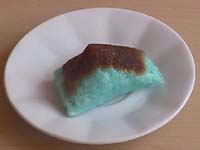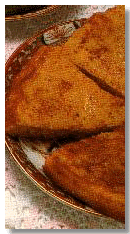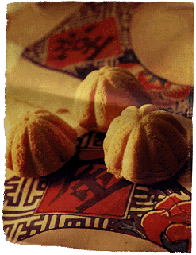
Page 1 | 2 | 3 | 4 |
10 recipes on each page.
11. Pineapple Tarts
Ingredients
 |
Ingredients for
filling
- 4 sweet fresh pineapples (about 1
kg total weight) or crushed canned pineapple
- 600 g granulated sugar
- 4 cloves
- 1 star anise
Ingredients for pastry
- 600 g plain flour
- 1 1/2 tsp baking powder
- 400 g butter, well-chilled
- 2 tbsp castor sugar
- 2 large egg yolks
- 2 drops vanilla essence
- 2 drops yellow food colouring
- Pinch of salt
- 80 ml boiling water (about 9 tbsp)
|
Method
Filling
- Skin and score pineapple, removing all
eyes by scoring in diagonal lines and gouging them out
with a sharp knife. Grate pineapples and squeeze out
juice using a muslin cloth.
- Chop or blend pineapple meat until fine.
Combine with sugar, star anise and cloves in a
heavy-bottomed pot and cook over low heat until almost
dry. Stir constantly until mixture is gluey and thick,
the consistency of thick jam. This can take up to an hour
if you are using fresh pineapple. Ready crushed pineapple
saves about 20 minutes of preparation time but the
cooking time remains the same. Cool and store in
refrigerator.
Pastry
- Sift flour and baking powder into a large
bowl. Rub butter lightly into flour mixture until mixture
is bread-crumbly. Beat castor sugar, egg yolks, vanilla
and salt lightly. Pour into flour mixture and add boiling
water. Mix well to make a pliable dough. Chill for an
hour.
- Knead pastry on a well-floured board or
non-stick worktop (marble is excellent for kneading)
until smooth. Roll out until about 1/2 cm thick. Using a
cookie cutter, (between 5 cm and 8 cm diameter depending
on how you want your tarts) stamp out pieces of pastry.
- Fill each with a heaped tsp of pineapple
and shape edges gently to contain the filling like a
fruit tartlet. If desired, roll out thin strips of pastry
and make a trellis pattern over filling. Use a pastry
friller to pinch edges for pretty effect.
- Place tarts on greased trays, with enough
space between for expansion. Glaze each with a little
beaten egg and bake in pre-heated oven at 200 degrees C
or gas mark 5 for 8 minutes. Reduce heat to 150 degrees C
and continue baking for 15 minutes until golden brown.
12. Coconut-top Ricecake - Pulut Inti
Ingredients
- 600 g quality glutinous rice
- 2 metric cups coconut cream from 2
grated coconuts
- Pich of salt
- 150 g palm sugar
- Pandanus Leaves
- 50 g granulated sugar
- 1 1/2 metric cups grated coconut
|
 |
Method
- Combine sugar, palm sugar and grated
coconut in a saucepan. Cook till sticky to make the
filling.
- Soak the rice overnight-drain and add
salt. Steam for 20 minutes in a colander lined with
banana and pandanus leaves, pouring a little coconut
cream at a time to keep it moist.
- Stir the rice. Cook a further 20 minutes
adding the rest of the coconut cream. Place hot rice in
small portions ina cone shaped banana leaves half filling
cone.
- Top with 1 teaspoon of the coconut
filling. Form a package and secure with a toothpick.
13. Durian Cake - Limpot Durian

Ingredients
- 680 g (1 1/2 lb) durian
pulp
- 55 g (2 oz) coarse sugar for
caramel
- 340 g (12 oz) coarse sugar
|
 |
Method
- Place durian pulp in a food
processor and blend or pound till it forms a smooth paste
and is free from lumps.
- Caramel the 55 g of sugar in a non-stick
wok till dark brown. Remove from heat, add the durian
and sugar and stir in pan. Return pan to heat, cook over
moderate heat till paste becomes firm. Keep stirring to
prevent paste burning. Reduce heat, stir until paste is
very dry and stiff. Remove from heat to cool.
- Divide durian paste into 4-5 parts
whilst still warm. Shape each part into a smooth thick
roll. Cuit lengths of thick plastic or use cellophane
pater to wrap the rolls firmly. Use thread or a thin cord
to tie both ends.
14. Honeycomb Cake - Bengka Ambon
- 30 g (1 oz) fresh yeast or 1
tablespoon dry yeast
- 2 teaspoons sugar
- 55 g (2 oz) flour
- 115 ml (4 fl oz) warm water
- 680 g (1 1/2 lb) grated coconut,
white
- 6 screw pine leaves, tied in a
knot
- 340 g (12 oz)
- 170 g (6 oz) sago flour or corn
flour
- 6 eggs, lightly beaten
- 1/2 teaspoons vanilla essence
- 1/2 teaspoon salt
- 2 drops yellow food colouring
|
 |
Method:
- Combine the yeast, 2 tablespoons of sugar,
55 g (2 oz) flour and 115 ml (44 fl oz) warm water in a
bowl. Stir till batter is smooth and leave in a warm
place till frothy, about 15 minutes.
- Squeeze coconut in small handfuls through
a piece of muslin for 340 ml (12 fl oz)No 1 milk. Set
aside in a bowl.
- Cook coconut milk, screw pine leaves and
sugar over very low heat till sugar is dissolved. Stir to
prevent burning at the bottom of the pan. Cool. Do not
allow the milk to boil. Remove the screw pine leaves.
- Put sago flour in a mixing bowl. Add
beaten eggs, vanilla essence and salt and mix by hand to
form a smooth batter. Add the coconut milk mixture,
yellow food colouring and stir till well combined.
- Add the risen yeast dough. Mix till well
blended. Rise mixing bowl with boiling water. Wipe dry
and pour batter into bowl. Cover bowl. Put in a warm
place and leave for 4-5 hours.
To bake ambon:
Heat brass cake mould over charcoal fire. Brush
with corn oil or boiled coconut oil. Stir the batter, fill three
quarters of the mould with batter and cook over moderate heat
till cake bubbles right through to the surface, resembling a
honeycomb. Remove cake from mould, repeat process with the rest
of the batter, brushing mould each time with boiled coconut oil
before pouring in the batter.
To brown top of cakes:
Place all the cakes on a tray. Put tray 10 cm
(4 in) from the heat under a hot grill for 3-5 minutes to brown
the surface of the cakes. Cool on a wire rack.
Note:
Benka Ambon can also be baked in a
single heavy brass or mould or brass 'kueh bolu' mould,
uncovered. Charcoal fire is better as the heats is more evenly
distributed than in electric or gas rings.
15. Steamed Tapioca Cake -
Nagasturi/Cassava
Ingredients
- 255 g (8 oz) grated tapioca
- 55 g (2 oz) sugar
- Pinch of salt
- 170 g (6 oz) coarsely grated
coconut (white)
- Few drops of red or green food
colouring
- 455 g (1 lb) coarsely grated
coconut, white
|
 |
Method:
- Peel tapioca, cut into halves lengthwise
and remove the centre fibre. Grate or chop tapioca in an
electric food processor till very fine.
- Put the grated tapica, sugar, salt and 170
g of grated white coconut in a bowl and mix well by hand.
Add a few drops of red or green food colouring to half of
the tapioca paste, mix well and add to the rest of the
tapioca paste to make a marbling pattern.
- Put tapioca paste in a shallow cake tin
and steam for 15-20 minutes. Remove from heat. Cool
completely before cutting into pieces. Serve with grated
coconut rubbed with a pinch of salt.
Note:
- To keep grated coconut from turning
sour,steam coconut in a shallow cake tin over rapidly
boiling water for 3-4 minutes. Remove and cool.
- Add 1 tablespoon screw pine juice to the
green food colouring (if used) as it gives a pleasant
fragrance after steaming.
16. Glutinous rice with coconut - Kueh
Lopis
Ingredients
- 455 g (1 lb) glutinous rice
- 2 tablespoons alkaline water
- 285 g (10 oz) palm sugar
- 2 tablespoons coarse sugar
- 170 ml (6 fl oz) water
- 5 screw pine leaves cut into
pieces
- 455 g (1 lb) tender grated
coconut, white
- Pinch of salt
|
 |
Method:
- Wash glutinous rice till water runs clear,
place in a container and add water to cover 5 cm (2 in)
above level of rice. Add the alsaline water, mix well and
evenly and leave to soak for 4 hours.
- Rinse rice and pour into a colander and
drain well. Set aside for 20 minutes.
- Make two cloth bags by cutting two pieces
of white material measuring 30 cm by 20 cm (12 in by 8
in). Fold the material into halves lengthwise and use
running stitch to sew it 0.5 cm from the edge.
- Use a string to tie one end of the bag 5
cm away from the edge. Divide rice into 2 parts. Fill bag
with one part. Pack the rice firmly and tie the bag to
resemble a large sausage. Repeat process with the other
bag.
- Put a low steaming rack at bottom of a
large saucepan. Add water and bring it to the boil. Put
in the 2 bags, and boil over constant high heat for 3
hours. Water level in saucepan should always be 8-10 cm
above the bags. Add boiling water from time to time.
- Remove bags to cool overnight. Untie bags
and use thick thread to slice lopis fairly thickly.
To boil the syrup:
Grate the palm sugar, add sugar, water, screw pine leaves and
boil in a saucepan for 10 minutes till syrup is fairly thick.
To serve:
Mix the salt evenly with the grated coconut. For each serving,
put 2 slices of lopis on a plate, and 2 tablespoons of grated
coconut on top. Pour some syrup and serve.
Note:
Remove the transparent glutinous rice grains from the chalky with
glutinous rice grains before making lopis. Dampen the bags of
glutinous rice and leave for 10-15 minutes before removing the
bags. This will allow the cloth bags to come off easily from the
lopis.
17. Red-Bean Layer Kuih
Ingredients
(A)
 |
(B)
- 300g rice flour
- 30g green pea flour (lek tau hoon)
- 80g corn flour
- 250g castor sugar
- 1/2 tsp salt
- 1/2 tsp alkaline water
- 1 grated coconut, add 1 litre
water and squeeze out for general santan
|
(C)
Method
- COMBINE ingredients (B) together, mix well
and set aside for 15 minutes. Stir and divide into two
equal portions. Mix in red beans in one of the portions.
Divide this red bean portion into two. Divide the other
half portion into two--leave one half plain, and add
pandan juice to the other half.
- Grease a square baking tray lightly with
oil. Set tray over steamer to heat up the tray.
- Pour in all the plain mixture and steam
for 4 minutes. Next pour in one half portion of red bean
mixture and steam for 9 minutes.
- Pour in pandan mixture portion and steam
for 11 minutes. Lastly, pour remaining red bean mixture
and steam for 5-6 minutes. Remove tray and set aside to
cool. Turn out kuih with the plain white layer as the top
(if preferred) and cut into slices to serve.
Footnote: Take 2 pandan
leaves, cut into small pieces and blend with 2-3 tablespoons of
water, strain to get pandan juice.
18. Green-white ricecake - Kueh Talam
It's SUCH a treat to have home-made nyonya kuih
for afternoon tea. In fact, nyonya kuih is great anytime -- for
breakfast, desserts or snacks. If you're having the girls over
for a cosy chit-chat, they would appreciate something sweet to
chew on.
Ingredients
Ingredients for bottom green layer:
(A)
- 70g rice flour
- 30g green pea flour
- 280ml water
 |
(B)
- 6 pandan leaves, cut into 3cm
pieces
- 250ml water
- A few drops of green colouring
- 250g sugar
- 1/2 tsp alkaline water
|
Ingredients for top white layer:
(C)
- 50g rice flour
- 1 1/2 tbsp green pea flour
- 1/2 tsp salt
- 75ml water
- 225ml pati santan -- from 1 coconut
Method:
- Mix (A) and leave aside to soak for about
10-15 minutes. Blend (B) in a liquidiser then strain to
get the pandan juice. Mix (A) and (B) together. Add sugar
and colouring. Cook over low heat and stir continuously
with a wooden spoon until batter becomes fairly thick and
translucent.
- Pour the hot sticky batter into a greased
20cm cake tin. Smoothen and level the surface with a
spatula. Steam over rapid boiling water for 20-30
minutes.
- To prepare the white layer mix (C)
ingredients together and soak for 10 minutes. Pour the
topping layer over the cooked green layer. Steam again
for about 10 minutes.
- Cool the kuih well. Slice into small
diamond-shaped pieces.
19. Nonya sponge cake - Kueh
bolu/bulu/bahlu
| Yin and yang
symbolise opposites and balance; yin being the
feminine representing fullness and roundness - as in
circles, globes or rings - and steeped in the rites of
fertility, eternity and the moon. The name simply means
round cake in Malay and probably derives from gai dan
gao (egg cake in Cantonese) but for their own
distinctive shapes forged through special brass moulds.
The favourite is again the goldfish or sometimes turtles
which symbolise longevity. The fact that they are made
with almost pure egg explains the yin connection, the egg
being the very essence of life. |
 |
Ingredients
 |
- 3 egg yolk, fresh
- 4 egg white, fresh
- 100 g : sugar
- 0.5 tsp : essence,
vanilla
- 100 g : flour,
wheat
- 1 tbsp : flour,
tapioca
- 0.25 tsp : baking
powder
|
Method
- Sieve together wheat and
tapioca flour and baking powder.
- Beat the eggs and sugar
till stiff. Add in vanilla essence. Fold in 20grms of
sifted flour with 100ml of egg batter.
- Slightly grease and heat
the special mould in a pre-heated oven of 250C. Spoon the
well-folded batter to fill about 3/4 level of each
compartment.
- Bake for about 5 minutes.
Repeat with the balance of the batter until all used up.
- When cool, store in an
airtight container.
20. Sugee Cookies
A traditional biscuit made from Ghee. So light
it literally melts in your mouth.
Ingredients
 |
- 125g butter
- 75g soft brown sugar
- 1/2 tsp vanilla essence
- 100g plain flour
- 75g sugee (Ghee)
- 25g ground almonds
- Almond strips
- 1 egg white, beaten
|
Method:
- GREASE baking trays lightly with butter
and preheat oven to 180 °C.
- Cream butter, sugar and essence until
light. Sift in flour. Add in sugee and ground almonds to
combine well into a dough, pinch off pieces and roll into
small balls and place on prepared trays. Press with a
fork. Brush lightly with egg white and press two almond
strips in the centre of each pressed out dough.
- Bake in a preheated oven for 13 to 14
minutes or until cookies turn golden. Leave on the tray
for 1 to 2 minutes. Remove onto a wire rock to cool.
Return to
Last revised: April 26, 2002.













